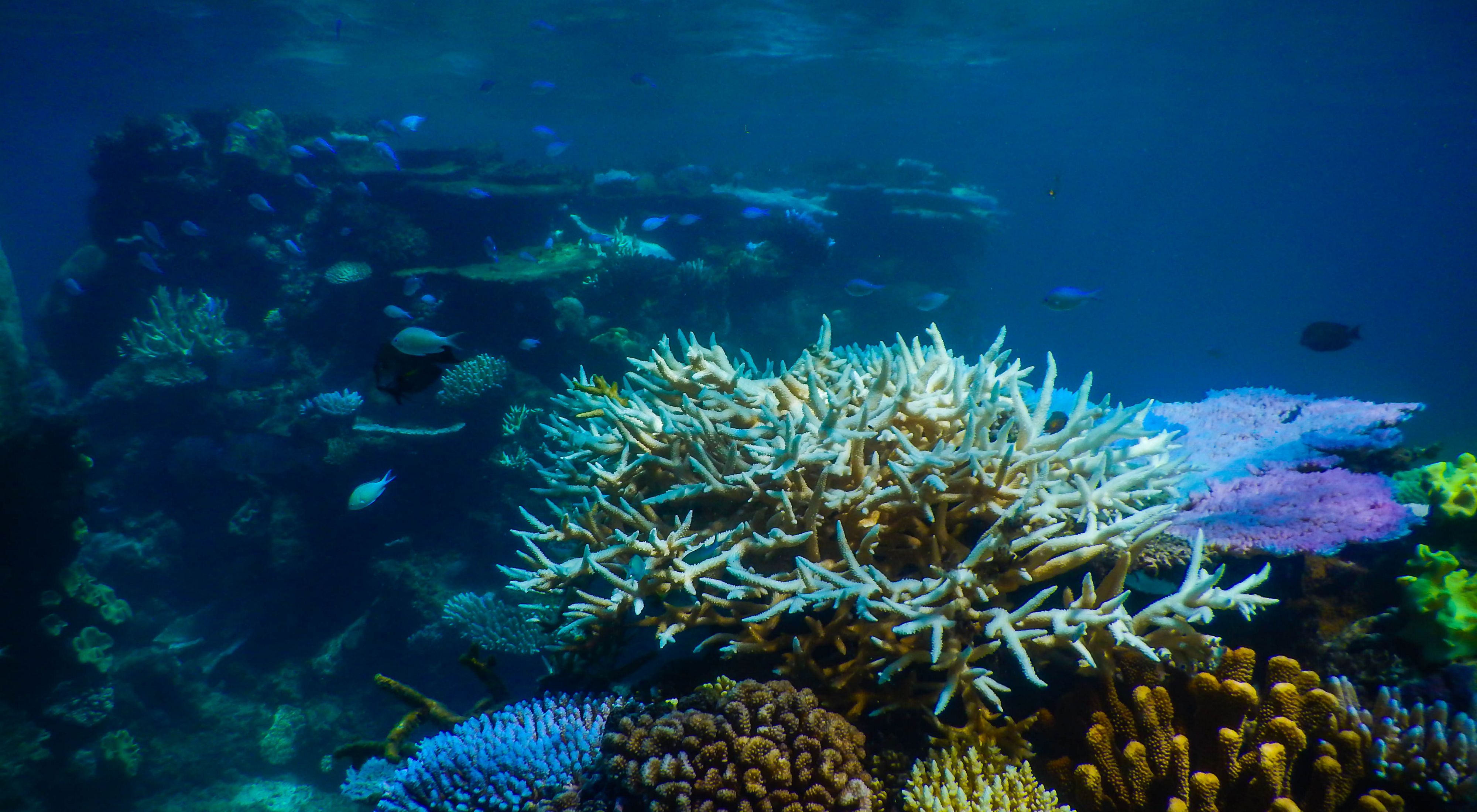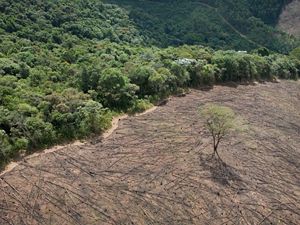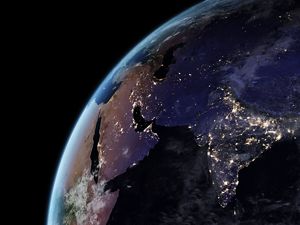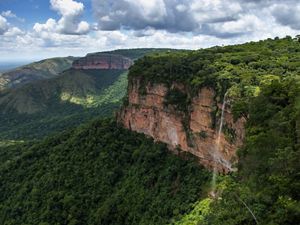The Great Barrier Reef stretches along Australia’s northeastern coast, a spine of 3,800 reefs and atolls arcing through the Coral Sea. Together, they form the largest living structure on Earth.
Few people outside of Australia know that the forests and woodlands that trace the northern Queensland coastline are a global deforestation hotspot. Nearly a decade of lax regulations allowed landowners to clear trees at a breakneck pace to make way for cattle and crops.
In 2015 to 2016, nearly 400,000 hectares disappeared, which amounts to about two-thirds the rate of deforestation in the Brazilian Amazon.
The story doesn't end there.
Without tree roots to secure the topsoil, widespread erosion soon follows. Northern Australia’s torrential wet-season rains carve 10-metre-deep gullies into the landscape, washing an estimated 17 million tonnes of sediment each year into the rivers and, eventually, out onto the Great Barrier Reef. Sediment loads at the river mouths increased between 5 and 9 times since European settlers arrived more than 200 years ago.
Research led by scientists from The Nature Conservancy (TNC) and the University of Queensland has identified the rivers most responsible for polluting the Great Barrier Reef.
“A total of 34 rivers feed into the Great Barrier Reef system, 17 of which are considered major inputs,” says Dr Nick Wolff, Climate Change Scientist at TNC.
“When these rivers dump onto the reef, where do they flow? And which reefs do they impact?” Without that information, managers have no way to prioritise which river areas to work in, in the hope of improving water quality on the greatest number of reefs.
What they found was four rivers, the Burdekin, Fitzroy, Tully and Daintree Rivers posed the greatest runoff risk of inorganic nitrogen onto coral reefs.
Biggest polluters to the Great Barrier Reef
Four Big Polluters Location of runoff points that has caused the most damage to the Great Barrier Reef
Quote: Dr Nick Wolff
It was a big surprise to see the reach of some of these rivers. For example, during 2011, the Burdekin River was the dominate polluter on 275 reefs, extending up to 450 km north of its mouth
It’s disturbing to discover the extent that pollutants can travel from individual rivers. Dr Nick Wolff found that during 2011, 275 reefs up to 450 kilometres north of the Burdekin River mouth were impacted.
The research used sophisticated oceanographic models and ‘virtual dyes’ to trace the movement of pollutants in rivers flowing onto the reef. Understanding the flow and direction of pollutants from each river and tracking where these pollutants end up has been a missing piece in the puzzle to protect the reef.
Now that we know where the biggest pollution problems are coming from and flowing to, critical land-based actions can be prioritised to reduce threats to the Great Barrier Reef and protect its future.
How river pollution contributes to coral bleaching
Once pollutants reach the ocean, they wreak subtle havoc with the reef’s delicate ecosystem. On the 700 or so reefs close to land, silt and clay can literally smother corals, either by covering them in a blanket of fine particles or by clouding the water and hindering photosynthesis.
Sedimentation runoff reduces the clarity of coastal waters and restricts the growth of light-dependent plants and animals, including corals. Light is an important factor for the growth and survival of coral reefs. Corals are combination of plant and animal parts, and their soft bodies harbour algae that need light to photosynthesize. The animal part of the coral depends on the algae to provide energy. While corals can grow and form reefs over a wide range of water clarity conditions, the nature of the reefs and their continued survival depends on receiving sufficient light. And with sediment particles continually resuspended by waves and currents, it’s difficult for coral in certain areas to get the much-needed light to survive.
Increased nutrients in the water also stimulate excessive growth of algae (e.g. seaweed) which can outcompete corals for space1.
These nutrients can also promote the breeding success of the destructive Crown-of-Thorns Starfish that is also a problem for the Great Barrier Reef. That’s why reducing nutrients flowing from polluting rivers to the reef is so critical in helping to sustain its health.
Coral bleaching and reef recovery
Scientists have found coral recovery rates across the Great Barrier Reef are declining. During the 18-year (1992 -2010) study period, the ability of coral reefs to bounce back from disturbances, such as bleaching, Crown-of-Thorns Starfish outbreaks or cyclones has declined, on average, by six-fold. It is the first time a decline in recovery rate of this magnitude has been identified in coral reefs2.
It is alarming that this steep decline in recovery was documented before the extreme bleaching events in 2016 and 2017. Recent research demonstrated that this back to back bleaching dealt such a severe blow to adult colonies of some important coral types that the number of young corals has declined by nearly 90%3. The implication is that there are simply not enough surviving adults to replenish the reef and that recovery rates may be even lower.
Coral recovery decline is likely driven by a combination of acute disturbances like coral bleaching and the ongoing effect of chronic pressures like poor water quality. Although it may sound strange to say, it is promising that poor water quality plays a role because it offers an opportunity. Armed with our research showing where river pollution is coming from, management agencies can target land-based interventions (e.g. land use improvements) that will strategically, and cost effectively reduce pollution. While such improvements will improve the resilience of some reefs4, these local interventions need to be coupled with the urgent need to reduce emissions.
Solving the pollution problem
The results allowed scientists to pinpoint reefs that are exposed to high levels of pollutants from just one or two rivers, which could help prioritise conservation efforts. “It’s hard to inspire landowners to take action if you vaguely say they’re impacting the reef,” says Wolff. “But now we can point to the exact reefs they are impacting on a map.”
The solution to reducing nutrient and sediment pollution on the reef lies in changing regulations for land-clearing and agriculture, both thorny political issues.
The Australian Government’s Reef 2050 plan outlines targets for an 80 percent reduction in river nutrient loads by 2025. But those targets are based on a 2009 baseline of nutrient loads, which is still up to nine times more nutrients than before European settlement.
Previous government programs tried to subsidise a switch to less nutrient-intensive practices, yet they proved ineffective. “The funding was handed out evenly across the catchment, spreading it vegemite-thin,” says Hugh Possingham, former Chief Scientist at TNC. “The problem is that just a tiny fraction of the landscape causes most of the problems.” Possingham advocates for a more targeted approach, where funding is distributed to areas contributing the most pollution.
Yet incentive programs alone will not be enough to save the reef, unless they are combined with clearing regulations. An estimated 37 percent of all land cleared in Queensland since 2012 is located in the Great Barrier Reef catchment area.
“Land clearing rules… are probably the cheapest way to actually make headway with water quality issues,” says Katharina Fabricius, a coral reef scientist with the Australian Institute for Marine Science. “Individual remedies are just band-aids if the regulation is not in place to prevent further land clearing.”
The Queensland State government recently passed stronger clearing regulations, which will help limit future clearing. But without restoration, erosion will continue on already-cleared land.
Until then, the reef remains at risk.
SOURCES:
1 Fabricius KE (2005) Effects of terrestrial runoff on the ecology of corals and coral reefs: review and synthesis. Marine pollution bulletin 50:125–146
2 Ortiz J-C, Wolff NH, Anthony KRN, Devlin M, Lewis S, Mumby PJ (2018) Impaired recovery of the Great Barrier Reef under cumulative stress. Science Advances 4:eaar6127
3 Hughes TP, Kerry JT, Baird AH, Connolly SR, Chase TJ, Dietzel A, Hill T, Hoey AS, Hoogenboom MO, Jacobson M, Kerswell A, Madin JS, Mieog A, Paley AS, Pratchett MS, Torda G, Woods RM (2019) Global warming impairs stock–recruitment dynamics of corals. Nature 568:387
4 MacNeil MA, Mellin C, Matthews S, Wolff NH, McClanahan TR, Devlin M, Drovandi C, Mengersen K, Graham NAJ (2019) Water quality mediates resilience on the Great Barrier Reef. Nature Ecology & Evolution 3:620
Get the latest updates on our work
Keep up-to-date on how we're helping to conserve Australia's iconic natural landscapes and crucial wildlife habitats.



